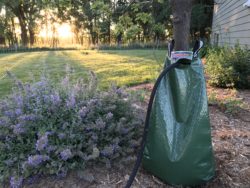Best Practices for Watering Trees.
Watering trees is one of the most critical parts of establishing or maintaining healthy trees. But, if not done carefully, it can also be something that can cause health related or tree establishment problems. This article is going to highlight some of the more important tips when watering trees.
Watering Trees: How often?
The frequency of watering trees is very important. It is important to remember that your trees are not anything like your lawn when it comes to water. Trees prefer, and do best, with large amounts of water that deeply saturates the entire soil profile up to it being soggy (its called field capacity). Then long periods until the next watering. Versus grass, that prefers and performs best with relative small amounts of water but done frequently (daily or so).
Watering trees with traditional lawn irrigation settings designed for green grass can be troublesome and tough on trees. First, it promotes shallow tree roots that have to compete more with the turf. It also lends the trees more susceptible to drought due to the shallow roots if the irrigation stops. Lastly, the amount of water reaching the tree roots varies greatly throughout the season. Often too much water in the spring and fall when the grass uses less in cooler weather. And then too little in the summer when grass uses a lot but the amount of watering stays the same.
If you have lawn irrigation, your best option to help your trees is to set your irrigation up to water once a week at the most. Or have areas where the trees are not watered by your lawn irrigation near the trunks. Have those areas mulched and water them separately.
If you don’t have lawn irrigation, an area of mulch under the drip-line is still recommended with separate watering from your lawn.
Watering Trees: How much?
The amount of water provided to a tree (too much or too little) is usually one of the more common baseline issues to a sick tree. As mentioned above frequency is an important factor when watering, but amount is more critical. Knowing how much water to provide can be tricky if you don’t know your soil type or how it drains. Poorly drained soils (clay or compacted) are more difficult to water effectively. Whereas well drained or sandy soils are difficult to provide enough water sometimes.
The main goal when watering trees is to fill all the small micro-spaces in the soil, but not the larger air spaces. This will allow the roots to breath. So in other words, do not water until the soil is soaking wet or squishy. And since soil types vary, the best advice I can give that will yield the best results across all kinds of soil types, is to water very slowly over a longer period of time. I tell my clients to imitate a drizzly, rainy day where about an inch of rain falls. Give time for the water to soak in slowly. An old school impact sprinkler set up until a dish is filled with an inch or so of water has performed the best.
Watering trees quickly, like with a hose (even on the slowest trickle), bucket, or by hand can often lead to the water running off. Or, to soak through too quickly for the roots to absorb it. Either way, you’re probably wasting a lot of water.
Young Trees
The best solution is a tree watering bag for trees up to 6 or 8 inches in diameter. These are durable plastic bags that zipper on around the trunk and hold up to 20 gallons of water. They slowly drip out water over about 8 hours to water a tree almost perfectly. New trees needing to establish need watering about once a week for a few years. Water young, established trees about twice a month in the hot dry summer months (July, Aug., Sept.).

Watering trees with a tree watering bag is probably the best method out there besides rain.
Mature Trees
For larger trees, a soaker hose placed around the trunk within the drip-line works well, or as mentioned above, use an impact sprinkler. Just have the water barely on so the water slowly drips out of the soaker hose. Space these waterings out during the hot summer months or drought conditions. Again, this will depend on the soil, but be careful not to water to frequently or too often. When in doubt, go stick your finger in the dirt, you will learn what you need to know.
Other Watering Tree Tips
Lastly, there are a few other items which need addressing when watering trees:
- Avoid getting water on the leaves or needles of trees.
- Water the soil and roots. Doing otherwise invites disease.
- Only water when it hasn’t been raining.
- Overwatering of young trees is a very common problem in Sioux Falls due to often poorly drained soils. If it has rained within the week more than an inch, do not water the tree again. Roots need air to breath.
- Water your trees, not your lawn during drought conditions.
- Grass will go dormant and come back later during a drought. Drought is very stressful for trees. Protect that long term investment. They don’t grow back as quick as grass.
- Water all your trees well in the Fall. Especially if it is dry.
- Tree roots grow in the fall, so having good soil moisture is very beneficial to trees. Also, conifers need the extra moisture to make it through harsh winter conditions in our area.
Here are some other blog topics you might find interesting:

